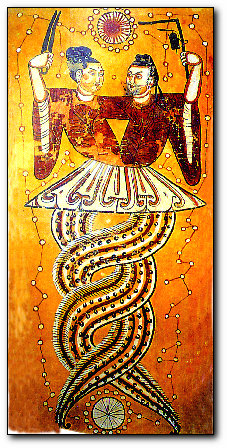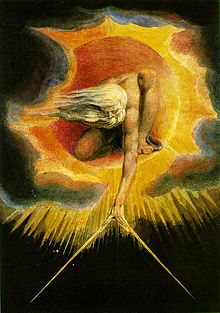Compass and Square
Previously, in Here Be Dragons!, I mentioned that Dragon-lore can be divided into several distinct categories; literal and metaphoric, or temporal and esoteric. That page mostly covered the literal and temporal aspects of British dragon-lore. This page takes a look at the more metaphoric and esoteric. Starting in India...
AnuNaga means "those who look like snakes" - the name describing its reptilian features. The prefix Anu means "similar to" and Naga means Serpent in ancient Indian language.
Ref : Anunnaki in India
Indian "AnuNaga" = Sumerian "Anunnaki" = "Those who from heaven came down to earth"

Nagas in Indian mythology also come from a different planet, and they prefer to live underground, building vast cities underneath the earth. This is identical to the portrayal of Anunnaki, who are the Gods of the Underworld. ... According to Sumerian texts, the Anunnaki was able to genetically modify the human race, which is possible only by altering our DNA. This genetic manipulation is depicted in ancient civilizations by intertwined serpents, which represent the DNA strands.
Then we have Nüwa 女媧 and Fu Hsi 伏羲, the founders of China with Square and Compasses, to measure the sky and land (geo-metry is the measure of the earth). They too are shown as being created from serpents, also symbolising the transfer of knowledge into human form. They taught humanity hunting, fishing, raising domestic cattle, writing and geometry.

Just as with AnuNaga, the shape of Nüwa and Fu Hsi's intertwined serpent tails is similar to the double helix of DNA, which encodes knowledge in human form. The Sun, Moon and Stars are depicted as well, along with variations of the 36 astronomical decans, which also appear in older Indian temples.
Nüwa and Fu Hsi are depicted as serpents as were the Widow Isis and her husband Osiris in Egypt. Isis lost her husband through the treachery of Typhon, and gave birth to Horus as a Widow. Horus is noted as the widow's son, as was Hiram Abif and Lazarus. The sacred Ished Tree of Egypt was a Tree of Knowledge with a serpent; pre-dating the same story in the Old Testament.
Nüwa and Fu Hsi are the Thoth-Hermes-Seshat (Hermes Trismegistus) of Ancient China, gods of weights and measures.
The serpent legs of Nüwa and Fuxi are almost identical to the serpents of Caduceus. That is the staff carried by Hermes, the Greek god of measure and trade.

In Egypt, Thoth was the god of writing, astronomy, mathematics, geometry, surveying, medicine, weights and measures, architecture and knowledge.
Seshat (she of the seven points, mistress of the House of Architects and mistress of the House of Books) is the female Thoth, inventor of writing, the Egyptian god of architecture, astronomy, mathematics and surveying (stretching of cords between poles) and the keeper of historical and scientific records - and anything that needed careful measurement and recording.

What are the seven points? In this picture, as it is green, does it represent a tree? But what could be more natural than a person (or God) being portrayed with the tools of their trade? Ropes for measuring were made from hemp, and the hemp plant has seven leaves.
"The portal (Door of Heaven) is opened for you by Seshat"
This symbolises a spiritual ascent or rebirth. The stretching of cords between poles was performed by a surveyor, preceeding the construction of a building or temple. Before the cords could be stretched, corner points or start and end positions had to be determined. In Egypt, surveying and measuring was done with a Merkhet. This combines a Cross Staff and Plumbline; effectively the square and compass in one instrument.

Ref : Crichton Miller and Merkhet
The Merkhet was also used as a clock. The measuring and fixing of corner points had to be done, not just at specific place, but also at a specific time.
I have grasped the stake along with the handle of the mallet. I take the measuring cord in the company of Seshat. I observe the progressive movement of the stars. My eye is now fixed upon Meskhetiu [the seven stars of the “Big Dipper”]. The god of time-keeping stands by me, in front of his merkhet. Then, I have established the four corners of the temple.
Ref : An inscription from the temple of Horus at Edfu.
Doesn't that feel like a very personal statement? Either as an initiation, or an act of devotion to Seshat. And see how similar it feels to this, from the Mayan text of The Popul Vuh :
Great is the recital, the history of the time when all the corners of the sky and earth were completed, and the quadrangulation, its measure, the four points, the measuring of the corners, the measuring of the lines, in heaven, in earth, at the four corners'And this, from the Book of Enoch ch. LX v. 2-6
Wherefore have they taken those long ropes and gone forth? He said 'They are gone forth to measure. These measures shall reveal all the secrets of the depths of the earth
These are the origins of William Blake's Ancient of Days, showing Urizen as the Great Architect of the Universe, with the power to create and constrain the universe itself. Holding the compasses at a square angle.

Footnote
Merkhat : Not to be confused with meerkat. Even though both stand upright and survey the horizon.
Compare the Merkhat .com
https://www.comparethemeerkat.com
Next : Ancient Music (carnyx-style)
